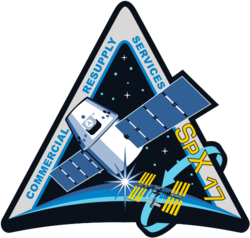 The SpaceX CRS-17 Dragon approaching to the ISS for RMS capture. | |
| Names | SpX-17 |
|---|---|
| Mission type | ISS resupply |
| Operator | SpaceX |
| COSPAR ID | 2019-025A |
| SATCAT no. | 44222 |
| Mission duration | 30 days, 14 hours, 22 minutes |
| Spacecraft properties | |
| Spacecraft | Dragon 1 C113 |
| Spacecraft type | Dragon 1 |
| Manufacturer | SpaceX |
| Dry mass | 4,200 kg (9,300 lb) |
| Payload mass | 2,482 kg (5,472 lb) |
| Dimensions | Height: 6.1 m (20 ft) Diameter: 3.7 m (12 ft) |
| Start of mission | |
| Launch date | 4 May 2019, 06:48 UTC [1] |
| Rocket | Falcon 9 Block 5 (B1056-1) |
| Launch site | Cape Canaveral, SLC-40 |
| End of mission | |
| Disposal | Recovered |
| Landing date | 3 June 2019, 21:10 UTC [2] |
| Landing site | Pacific Ocean off Baja California |
| Orbital parameters | |
| Reference system | Geocentric |
| Regime | Low Earth |
| Inclination | 51.6° |
| Berthing at ISS | |
| Berthing port | Harmony nadir |
| RMS capture | 6 May 2019, 11:04 UTC [3] |
| Berthing date | 6 May 2019, 13:33 UTC |
| Unberthing date | 3 June 2019 |
| RMS release | 3 June 2019, 16:01 UTC [4] |
| Time berthed | 27 days |
 NASA SpX-17 mission patch | |
SpaceX CRS-17, also known as SpX-17, was a Commercial Resupply Services mission (CRS) to the International Space Station that was launched aboard a Falcon 9 rocket on 4 May 2019. [5] The mission was contracted by NASA and was flown by SpaceX. An umbilical connection from the strongback remained attached to the spacecraft and is visible in photos taken of it approaching & attached to the ISS. [6]







